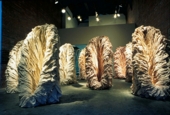
1964 Born in Kagawa. Japan
1984-1988 Musashino Art University, Tokyo ( Bachelor of Fine Arts )
1988-1990 Musashino Art University, Tokyo ( Master of Fine Arts )
1993~ Assistant Lecturer of Okayama Prefectural University
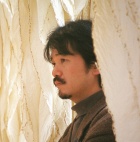

| 1964 Born in Kagawa. Japan1984-1988 Musashino Art University, Tokyo ( Bachelor of Fine Arts ) 1988-1990 Musashino Art University, Tokyo ( Master of Fine Arts ) 1993~ Assistant Lecturer of Okayama Prefectural University | 
|
| 1988 | Gallery NW house, Tokyo |
| 1989 | Gallery Gallery, Kyoto
Gallery NW house, Tokyo |
| 1990 | Gallery Gallery, Kyoto |
| 1992 | Fuji Gallery, Osaka |
| 1993 | Gallery NW house, Tokyo
Gallery Gallery, Kyoto |
| 1994 | Gallery Space 21, Tokyo
BOUTIQUE KANSAI, Tokyo |
| 1995 | AD&A Gallery, Osaka |
| 1997 | Kibikogen Art House, Okayama |
| 1998 | TOYOTA Community Art, S.Stage Ifukucho, Okayama
Tamagawa Takashimaya Shopping Center South Palsce, Tokyo Okayama Symphony Hall 3rd Floor's Window, Okayama Gallery Gallery, Kyoto |
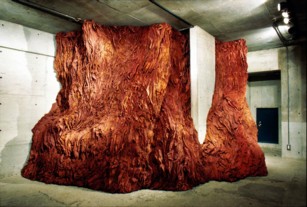
| 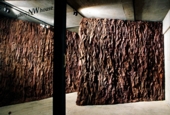
|
| 1989 | 2nd International Textile Competition , Kyoto Municipal Museum of Art
Three Persons Exhibition, Seibu Department Store, Tokyo |
| 1991 | Piramid, Studio COM, Kyoto |
| 1992 | 15th Biennale Internationale de la Tapisserie, Lausanne (tour)
Contemporary Art on the Wall, Gallery Muu, Kyoto Textile Miniature Works, Contemporary Art of Japan, Gallery Gallery, Kyoto (tour) |
| 1993 | 2nd Annual International "In Our Hands" Exhibition, Nagoya
Miniartextile, Studio Mimmo Totaro, Como, Italy Kansai Super Museum "Hello! Russia" Exhibition, The Museum, Tokyo |
| 1994 | 3-D Miniature Works "On The Wall", Wacoal Ginza Art Space, Tokyo (tour) |
| 1995 | Textile Miniature Works, Contemporary Art of Japan, Gallery Gallery, Kyoto (tour)
Fiber Art Exhibition, MEDIA SANYO, Yokohama Contemporary Japanese/Brazilian Artists, Museum of Contemporary Art of the University of Sao Paulo |
| 1996 | KIRIN Contemporary Award '96, KIRIN Art Space Harajuku, Tokyo (tour)
Landmark Hall 3rd Anniversary "COLLABORATION", Landmark Hall, Yokohama Mini Drawing Exhibition, Gallery Gallery, Kyoto |
| 1997 | The Time of the Art, 2 Persons Show, DAVID HALL, Okayama
Textile Exhibition, Okayama The Eyes of the Contemporary Artists, Okayama Synthetic Center, Okayama |
| 1999 | KIRIN Contemporary Award OB 5 Persons Show, KIRIN Plaza Osaka, Osaka
Textile Exhibition, Mizushima Salon, Okayama |
| 2000 | 2 Persons Show, Gallery 99/00, Okayama
folding -an exhibition of works in fiber- , The Museum of Arts Crafts¥ITAMI, Hyogo |
| 1991-1998 | Today's Art TextileV-XII, White Gallery, Kagoshima, etc. |
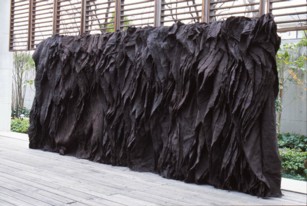
| 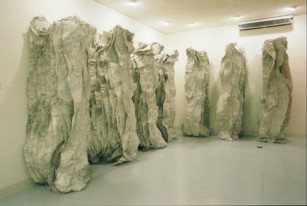
|
Museum of Contemporary Art of the University of San Paulo, Brazil
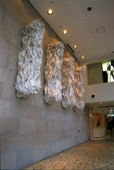
| 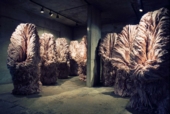
| 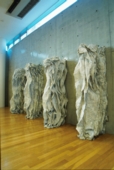
|
The phrase 'possibility of change in cloth as material' has been key expression for the production of my work. Since I majored in textiles in university, my first purpose was to learn the basic techniques of dying and weaving. But thinking about the meaning of the phrase eventually weakened my interest in the command of techniques for various constructions of threads in weaving work, or constructing colors or figures on cloth to make a piece of original cloth. Instead, I came to produce repeated experimental works to find a way of expression that mutually resonated with my emotions. I believed that my production by recognizing cloth as a mere material, not creating cloth itself, should not depend only on the common allure of cloth such as softness and warm expression, nor the skill to emphasize it.
In those days, I had an opportunity to visit a limestone cavern. Interested in its seductive undulation of stalactites and stalagmites in various figures created through hundreds of thousands years, I stayed in that space with countless numbers of these things for a long time.
Coming back to my university, I started to make a sample from the image of the stalactites. Since my major was textiles, cloth was inevitably chosen as a material. But merely replacing the undulation on the surface of a stalagmite with cloth would only be a replica of nature. Many more experiments led me to an idea before I found the form in my own work. As lime in rain or ground water dripped over time, to make such exceptional figures, plain cloth as material could be used to create different figures by accumulating thousands or tens of thousands of pieces of it. The possibility of cloth as material should be researched more rather than applying existing techniques. When I reached this concept, the way in which I was related to the cloth in my work was determined. For 10 years since then, external impressions of my work have changed without any change of technique in stitching tiny cut-off pieces of cloth together.
Thus, the starting point of my current work was my choice of cloth as material and my research into my own technique. Listening to my story, some people suggest that an artist should first decide a theme or what is to be expressed. They feel that the material and the technique should be secondary. Of course, I won't ignore the way that a theme usually precedes the choice of materials and techniques. On the other hand, my personal interest indicates what exists inside myself either physically or mentally, and it is important for me to mentally sense some kind of reality when I faces my own work. I still believe it is essential for me to create surface and expression of my work at first.
From 1988 to 1989, I had presented a renovated space itself as my work. An assembly of clothes was attached over a wall or all walls in a space were covered up, and so forth. My impression of these works was an internal, cavern-like space. Here, in this space, I could feel at home. At the moment we were born, the amniotic fluid we had been immersed in was succeeded by a soft cloth to wrap us. This touch of cloth turned into baby's subconscious memory and has been transmitted up to current adult feelings, so that one feels at home when he sees or touches a familiar cloth, much more stay in a space surrounded by cloth. Thinking about the transformation from cloth to something else, I wanted to create another expression by adding something to cloth. Later, I eventually agreed to the idea that the texture of cloth itself contains something directly effective, by the memory of touching, on what we have accumulated in our minds. This might make stronger impression when facing a work.
After the experimental works to make a space itself a work ---- from 1989 to 1992 I started to move away from a flat wall and toward a 3-dimensional shape ------ since 1993, I have been producing a work with the expression 'Memory before Birth' in mind. I happened to find the expression in a book.
A mother's womb is a place everybody used to be in. However nobody has a memory of when he was an unborn child, much less before an unborn child. Nevertheless, Mr.Shigeo Miki, the author of 'the world of an unborn child', insists in his book that beside memory accumulated since childhood, there exists 'Life Memory' to firmly support the foundations of one's life.
The book says that Life Memory is what has been absorbed one thing after another into each one of our body's cells since the beginning of life on earth. It has been continuously accumulated and handed over through generations. It is this memory that enables human beings to replay the evolutionary process, in only a short period of time during a human's birth in a mother's womb.
As proof, the book takes the drastic change of an unborn child's figure during the first 30 to 40 days after impregnation, as well as the occurring process in the blood vessels and the nerve fibers. For instance, changes in the head shape, big position movements of the nose and the eyes, a rift on the neck on the 32nd day which looks like a gill slit and the process of forming mouth's shape, all these changes about the face seem just the same as the evolutionary process from fishes to amphibians, reptiles, mammals, and primates. If we take it seriously, all of us have experienced the evolutionary process in the womb. The memory doesn't emerge in our daily lives, but somehow it is certainly inherited in our cells and transferred to the next generation again.
I wanted to find a form of my work from this phrase 'Life Memory' but its realization was not easy. So, I had to continue to make experimental works that covered up a gallery wall.
After these experiments piled up, an unexpected turning point came when my father had his stomach removed. After his operation, I had a look at his stomach and peritoneum. Having many kinds of feelings at once, I didn't hesitate so much to look at them, because they were quite clean up. Far from hesitation, I was sort of impressed by their texture and color. The impression stuck to me even while I was thinking of my works. And I felt that inside myself it and the phrase 'Life Memory' began to be intertwined in an intricate way.
From organs to cells -------- the memory confined in them has been handed over from the primeval age. This concept made me produce my body of work after 1993.
The limestone cavern and the organs removed from my father's body. They have common characteristics from the view point of objects, even though they seem to be totally different. Once you try to go back along their histories, each of them brings you to the ancient age. I feel that I myself am just a microscopic existence in such a perpetual stream, but this body confines a vast universe. Life Memory from the primeval age that exists inside my very body. I intend to be strongly conscious of it to produce my work.
Kiyonori Shimada |
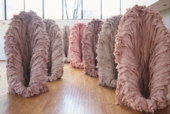
| 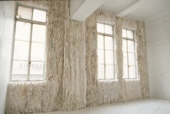
| 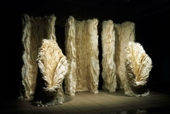
|